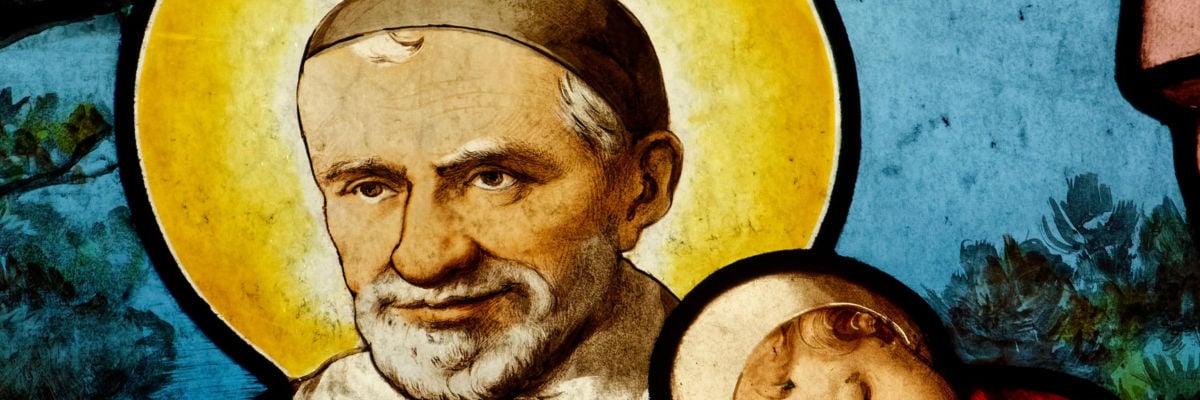
Who Was St. Vincent de Paul?
St. Vincent de Paul (1581-1660) was a French Catholic priest best known for his dedication to serving the poor with Christlike love, both regarding their material and spiritual well-being, as well as for his similar commitment to the sick, orphaned children, convicts, and slaves. In his early life, Vincent had great ambition to take care of his family and rise in the Church, and yet he channeled those desires to lead the societal elite to serve those in great need while fulfilling their own vocations. He also founded one religious order and co-founded another to achieve the same purpose. He also served as a catalyst for other great change in the Church and society, including through helping found seminaries and reform religious orders, serving as a counselor to King Louis XVIII, and helping lead the early fight against the heresy of Jansenism.
Vincent was born to two peasant farmers in the small southern village of Pouy, France. From a young age, he helped his mother and father with working the land and tending the family’s livestock. His parents also made sure that he received a good education, benefiting from the local Franciscans. Vincent showed great intellectual promise and other talents, and so he entered seminary at just age fifteen. Four years later, in 1600, he was ordained a priest.
In 1605, while Vincent was sailing home, Turkish pirates abducted and sold him into slavery. Vincent spent two years in captivity and then escaped with his Muslim master and his master’s wife, both of whom he had helped convert back to the Faith.
How Did St. Vincent Impact the Church?
Upon Vincent’s return to Europe, he continued studying theology and serving as a parish priest. He also began devoting his life to forming and reforming clergy and religious. In addition, he started his various charitable efforts, which gave birth to the Vincentian Family, a group of religious congregations and lay associations named after the great saint:
- the Congregation of the Mission, which St. Vincent officially founded in 1625, but whose origin dates to a homily he gave at Folleville, France, on the Feast of the Conversion of St. Paul in 1617. Today, the Vincentians, as the Congregation is commonly known, number about four thousand missionaries (priests and brothers) who serve in eighty countries throughout the world.
- the Ladies of Charity, a lay association of women dedicated to serving the poor which Vincent founded as the Confraternities of Charity in 1617. Today, they are globally organized as the International Association of Charity (AIC), with more than 250,000 members.
- the Daughters of Charity, founded by St. Louise de Marillac (1591-1660) and St. Vincent in 1633. The Daughters’ motto is, “The charity of Jesus crucified impels us.” There are currently about seventeen thousand Daughters serving in nine countries around the world.
- the Sisters of Charity, which St. Elizabeth Ann Seton (1774-1821) founded in Emmittsburg, Maryland, in 1809. The Sisters of Charity Federation serves in North America and numbers about four thousand members.
- the Society of St. Vincent de Paul, which Bl. Frédéric Ozanam (1813-1853) founded in Paris in 1833. The Society has more than 850,000 members serving in 150 countries.
What Is St. Vincent de Paul the Patron Saint of?
St. Vincent de Paul is the patron saint of charitable societies. His life’s work alongside St. Louise de Marillac, who co-founded the Daughters of Charity with St. Vincent, created lasting institutions dedicated to serving the poor. Pope Clement XII canonized him in 1737, and Vincent’s feast day is celebrated on September 27.
Free Download | St. Vincent de Paul Prayer Card
What Is the St. Vincent de Paul Society?
The Society of St. Vincent de Paul, founded in 1833 by Bl. Frédéric Ozanam, carries on Vincent’s mission of serving those in need. Today, the Society operates worldwide, providing food, clothing, and housing. Many local chapters, including those based at parishes around the country named after the great saint, offer direct support to their communities.
Does St. Vincent de Paul Help With Rent?
Yes. Many local St. Vincent de Paul Society chapters assist with urgent needs like rent, utilities, or food. Each chapter sets its own guidelines, but the mission remains the same: offering Christlike charity to those in need.
Saints Help Beget Saints
St. Vincent helped many people grow in holiness, including through his service as a renowned priest confessor. He also benefited from his friendship with St. Francis de Sales, who inspired Vincent to become “more gentle and loveable.” In addition, Vincent collaborated with St. Louise de Marillac, founding together the Daughters of Charity. He also inspired Bl. Frédéric Ozanam, a layman, father, and college professor who founded the Society of St. Vincent de Paul at age 20, as well as St. Elizabeth Ann Seton, whose Sisters of Charity adopted the rule of the Daughters of Charity. There is also Bl. Rosalie Rendu (1786-1856), a Daughter of Charity who served the poorest of the poor in Paris, and also helped introduce members of the Society to this charitable work.
Perhaps the most renowned of Vincent’s disciples, though, is St. Catherine Laboure (1806-1876), a Daughter of Charity who, at age nineteen, had a dream in which an elderly priest spoke to her. She saw herself praying during the sacrifice of the Mass in the church of her native hamlet, Fain-les-Moutiers. After Mass, the priest celebrant, an elderly gentleman, motioned to Catherine to come forward. She ran away in fear, and yet the dream continued to unfold. Catherine was then besides the bed of a sick person, and the same priest was again present, saying, “My daughter, it is good to care for the sick. You run away from me now, but one day you will be happy to come to me. God has designs on you! Do not forget it!”
Several years later, while serving at a boarding school in Chȃtillon-sur-Seine, Catherine visited the religious house of the Daughters of Charity in the same town. In being brought into their parlor, she saw the portrait of an old priest on the wall. In taking in his gentle gaze toward her, she recognized him as the man from her dream. “There is the priest I saw in my dream!” she exclaimed. “It is truly he, but who is he?” “Our Founder,” replied the young sister who was accompanying her, “St. Vincent de Paul.”
Catherine recalled St. Vincent’s words to her: “You will come to me. . . .” And now she had indeed come. A great peace and joy flooded her heart. Several months later, having been transferred to Paris, Catherine would begin to have a series of Church-approved apparitions of the Blessed Mother. They culminated in Catherine’s receiving from Mary the Miraculous Medal, which has since been given to countless souls around the world. Catherine’s incorrupt body remains today in the chapel in which she had the apparitions (Rue du Bac).
St. Vincent de Paul’s Lasting Legacy
From the first Confraternities of Charity he founded to the international Society that now bears his name, St Vincent de Paul’s influence continues to shape parishes, schools, and many efforts to serve the poor. Popes from Clement XII to Leo XIII have praised his model of holiness and service. When his body was exhumed, his heart was found incorrupt. This serves as a testament to the love that marked his life. May we, like St. Vincent de Paul, strive for hearts filled with love, compassion, and charity.
St. Vincent de Paul, patron saint of charity, pray for us!



